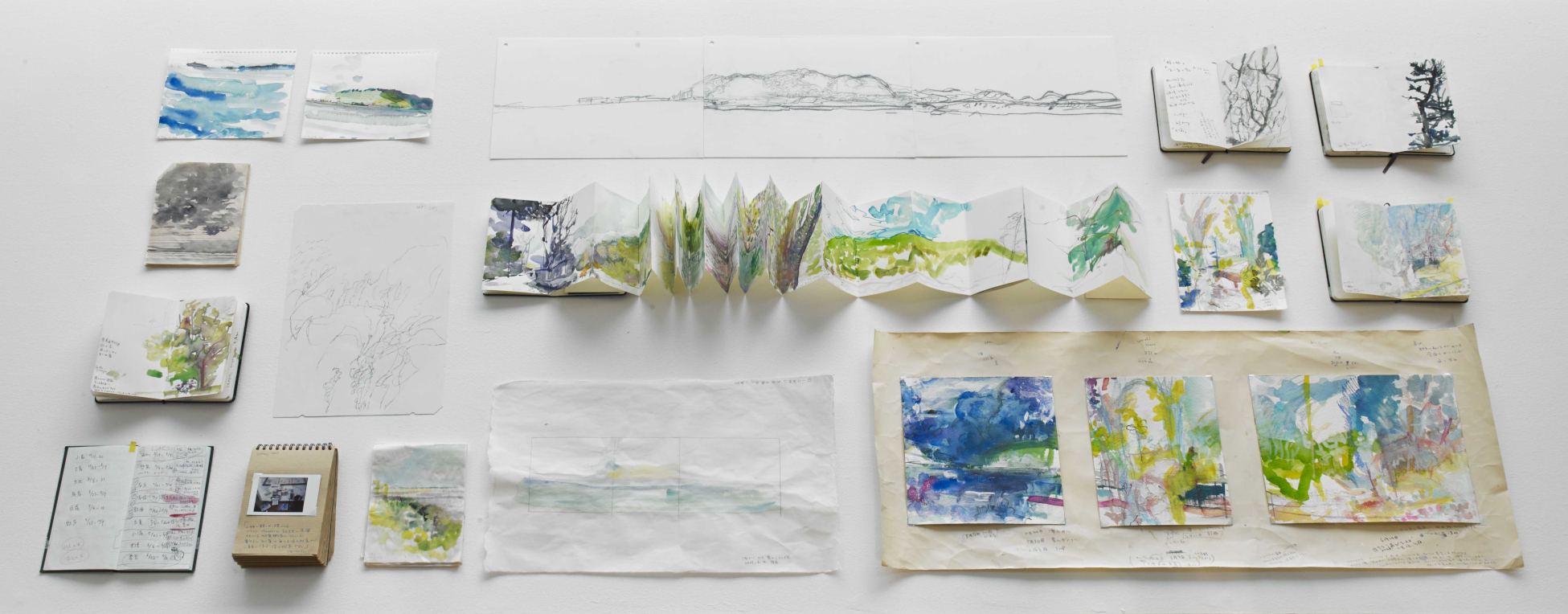津上みゆき TSUGAMI Miyuki

《View, the passage of time, Nakashimagawa River, 1:10pm 8 Oct 18》2019年 顔料・アクリル・その他、カンヴァス 各158×300cm (2点) 撮影:金川晋吾 Courtesy of ANOMALY
View, the passage of time, Nakashimagawa River, 1:10pm 8 Oct 18, 2019, Pigment, Acrylic and Others on Canvas, each 158×300cm (2 pieces) Photo by KANAGAWA Shingo Courtesy of ANOMALY
津上みゆき
TSUGAMI Miyuki
1973年、東京都生まれ、大阪で育つ。現在、神奈川県在住、活動。
「見る」こと
景色というのは
みたいようにしか
みれない。
作家のこの言葉は「見る」という行為に宿る歴史性について言及したものであると捉えることができる。感覚器を介し知覚される外界の情報は決してそのままで像を結ぶことはなく、認識の枠組みを通した取捨選択と編集を経たうえで形を成し意味を獲得する。そしてその認識の枠組み自体は、主体の経験と、その経験をそれとして成り立たせる言語を含めた広い意味での文化とによって条件付けられるという歴史性を帯びている。この意味で「みたいようにしか/みれない」という津上の言葉は「みえているようにしか/みれない」と言い換えることも可能だろう。対象をあるがままの姿で捉えることの不可能性、認識の枠組みによってもたらされる「見る」ことの限界について語っているように思われるこの作家の言葉はしかし、その枠組みを自覚的に組み替えながら「見る」ことの可能性を切り拓きたいと欲する作家の願望の表れであるとも読める。
方法論
津上は日々スケッチを繰り返す。「趣味(日記)に近い」と自らが語るそのスケッチは、「見る」ことの可能性を切り拓くための日々の実践なのだろう。ここで言う「見る」こととは視覚的な経験に限られるものではない。冒頭に引いた「(風景は)私が感知し記憶しないと記録されることもなく、/流れ去っていくこと。」という津上の言葉にもあるように、それは「感知」と言い換えても良いものだ。流れ去りつつある風景、過ぎ去りつつある「いま」。津上のスケッチには、それを自分はどのように「見ている」のかという不断の問い掛けが潜んでいる。
作家は屋外でのスケッチをアトリエに持ち帰り、そこに留められた線や色を客観的に分析・検証しつつ幾つものスタディを重ねたうえでカンヴァス画を制作する。言葉を換えれば、スケッチは津上が風景を「見ている」ことの証拠であり、スタディはその証拠をもとに立てられ得る、風景をどのように「見ていた」のかということに関するいくつかの仮説、カンヴァス画は仮説の妥当性を吟味したうえで下される、風景をこのように「見た」という結論であると言えようか。この独自の方法論において、津上は経験の当事者であると同時にその検証者であり、そして判定者でもある。「私は確かに風景をこのように見た」。特定の場所、特定の日時がタイトルに付される津上のカンヴァス画は、このように確信的であり断定的である。
野中 明「『View』ー津上みゆきの仕事」、津上みゆき展「View ー 人の風景」カタログ、長崎県美術館、2019年より抜粋
Born in Tokyo, Japan, 1973. Grew up in Osaka, Lives and works in Kanagawa, Japan.
Seeing
You can only see a view the way you want to see it.
We can understand these words of the artist as relating to historical context inherent in the act of “seeing.” Information about the external world received through our sense organs never forms an image as it is, rather meaning is acquired by sorting and editing through the framework of perception. And this framework of perception itself has historical context, as it is conditioned by the subject’s experience and the culture – in the broad sense, including language – that shapes this experience. In this sense, it is possible to rephrase the sentence “You can only see a view the way you want to see it” as “You can only see a view as it appears to you.” However, the words of the artist, who seems to speak of the impossibility of capturing a subject as it actually is and about the limitations of “seeing” due to the frameworks of our perceptions, can also be interpreted as expressing her desire to consciously rearrange those frameworks and broaden the possibilities of “seeing.”
Methodology
Tsugami makes a large number of sketches as part of her regular working process. These sketches, which she describes as “something like a personal diary,” are a daily practice that opens up the possibilities of “seeing.” Here the term “seeing” is not limited to visual experience. As in the quote from Tsugami at the beginning,“(A view) is everything that flows away and disappears, if not I do not record it with my senses and memory” it could be reworded as “sensing.” The view flows away from the viewer, as the present moment flows into the past. Tsugami’s sketches are full of constant questioning about how she “sees” the scene.
The artist brings outdoor sketches back to the studio, and completes a canvas after producing several studies while objectively analyzing and verifying the lines and colors of the sketches. In other words, sketches are evidence of Tsugami’s “seeing” views, her studies are built on that evidence, hypotheses of how she saw the views, and the paintings on canvas are conclusions, the landscape “seen” in a particular way after examining the validity of the hypothesis. With this unique methodology, Tsugami both experiences things first-hand and verifies and judges them: “This is how I saw the view.” Thus Tsugami’s paintings on canvas, with specific locations, dates and times added to titles, gain conviction and certainty.
-Extract from NONAKA Akira, “Views: The Work of Tsugami Miyuki”, Tsugami Miyuki: View — People and Landscapes (Exh.Cat.), Nagasaki Prefectural Art Museum, 2019 (Translated by Christopher STEPHENS)
更新された最新の情報は、作家のウェブサイトをご覧ください。
Please refer to the artist’s website for new updates.

《制作ノート》2019年
スケッチ:鉛筆、色鉛筆、水彩、ペンなど/紙、塩ビ板
スタディ:鉛筆、色鉛筆、水彩、ペン、アクリル、パステル、顔料、ポラロイド写真/紙
「みえるもののむこう」神奈川県立近代美術館 葉山での展示 撮影:山本糾 Courtesy of ANOMALY
Studies and notebooks, 2019
Sketch:Pencil, Colour pencil, Watercolour, Ink and others on Paper, PCV Plate
Study:Pencil, Colour pencil, Watercolour, Ink, Acrylic, Pastel, Pigment and Polaroid Photograph on Paper
Installation view at Beyond the Visible, The Museum of Modern Art, Hayama, Japan
Photo by YAMAMOTO Tadasu Courtesy of ANOMALY

《View, the passage of time, Gokurakujizaka, 20 and 29 Feb. 2020》2020年 顔料・アクリル・その他、カンヴァス 194×227.8cm Courtesy of ANOMALY
View, the passage of time, Gokurakujizaka, 20 and 29 Feb. 2020, 2020, Pigment, Acrylic and Others on Canvas, 194×227.8cm Courtesy of ANOMALY

《View, the trace of time, Narutakigawa River, 2:52pm 6 Oct 18/2019》2019年 顔料・アクリル・その他、カンヴァス 259.2×194.0cm 東京国立近代美術館蔵 Courtesy of ANOMALY
View, the trace of time, Narutakigawa River, 2:52pm 6 Oct 18/2019, 2019, Pigment, Acrylic and Others on Canvas, 259.2×194.0cm Collection at The National Museum of Modern Art, Tokyo Courtesy of ANOMALY

